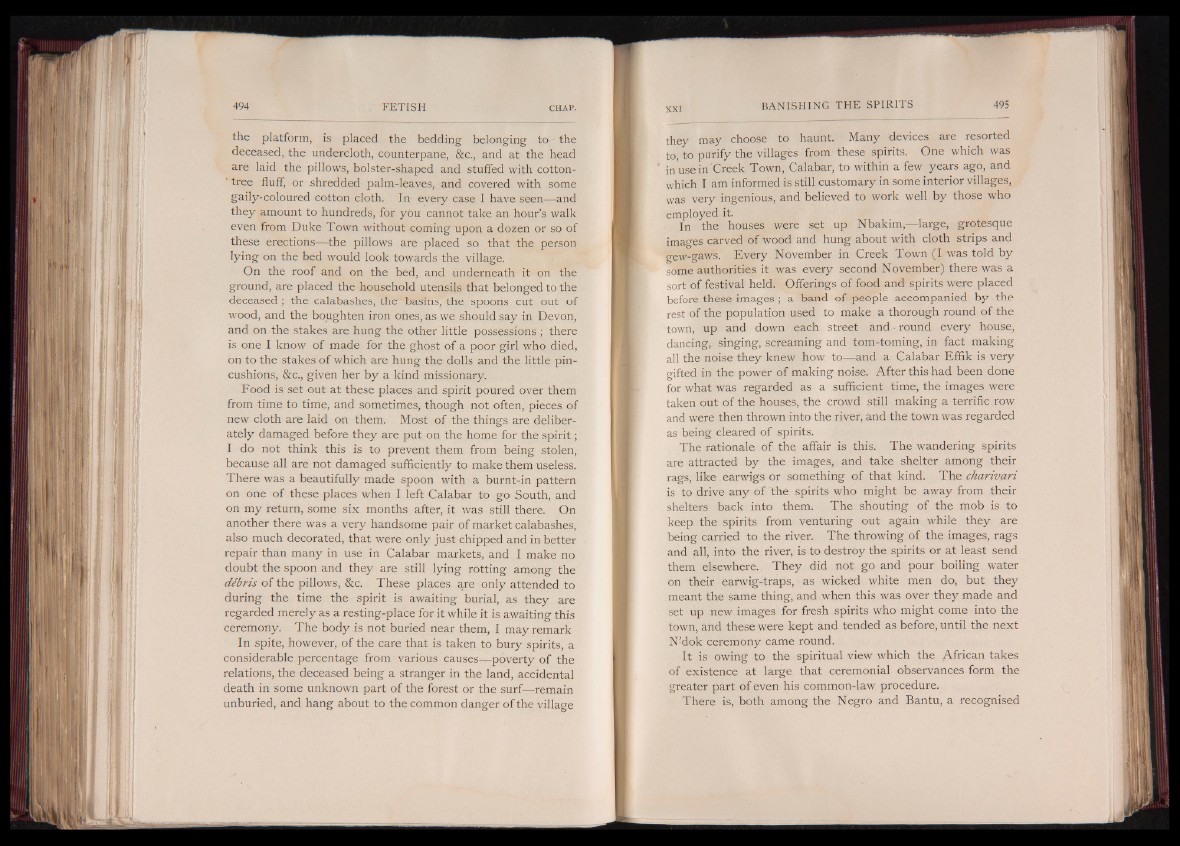
the platform, is placed the bedding belonging to the
deceased, the undercloth, counterpane, &c., and at the head
are laid the pillows, bolster-shaped and stuffed with cotton-
' tree fluff, or shredded palm-leaves, and covered with some
gaily-coloured cotton cloth. In every case I have seen— and
they amount to hundreds, for you cannot take an hour’s walk
even from Duke Town without coming upon a dozen or so of
these erections— the pillows are placed so that the person
lying on the bed would look towards the village.
On the roof and on the bed, and underneath it on the
ground, are placed the household utensils that belonged to the
deceased ; the calabashes, the basins, the spoons cut out of
wood, and the boughten iron ones, as we should say in Devon,
and on the stakes are hung the other little possessions ; there
is one I know of made for the ghost of a poor girl who died,
on to the stakes of which are hung the dolls and the little pincushions,
&c., given her by a kind missionary.
Food is set out at these places and spirit poured over them
from time to time, and sometimes, though not often, pieces of
new cloth are laid on them. Most of the things are deliberately
damaged before they are put on the home for the spirit ;
I do not think this is to prevent them from being stolen,
because all are not damaged sufficiently to make them useless.
There was a beautifully made spoon with a burnt-in pattern
on one of these places when I left Calabar to go South, and
on my return, some six months after, it was still there. On
another there was a very handsome pair of market calabashes,
also much decorated, that were only just chipped and in better
repair than many in use in Calabar markets, and I make no
doubt the spoon and they are still lying rotting among the
débris of the pillows, &c. These places are only attended to
during the time the spirit is awaiting burial, as they are
regarded merely as a resting-place for it while it is awaiting this
ceremony. The body is not buried near them, I may remark
In spite, however, of the care that is taken to bury spirits, a
considerable percentage from various causes— poverty of the
relations, the deceased being a stranger in the land, accidental
death in some unknown part of the forest or the surf—remain
unburied, and hang about to the common danger of the village
they may choose to haunt. Many devices are resorted
to, to purify the villages from these spirits. One which was
in use in Creek Town, Calabar, to within a few years ago, and
which I am informed is still customary in some interior villages,
was very ingenious, and believed to work well by those who
employed it.
In the houses were set up Nbakim,— large, grotesque
images carved of wood and hung about with cloth strips and
gew-gaws. Every November in Creek Town (I was told by
some authorities it was every second November) there was a
sort of festival held. Offerings of food and spirits were placed
before these images ; a band of people accompanied by the
rest of the population used to make a thorough round of the
town, up and down each street and round every house,
dancing, singing, screaming and tom-toming, in fact making
all the noise they knew how to— and a Calabar Effik is very
gifted in the power of making noise. After this had been done
for what was regarded as a sufficient time, the images were
taken out of the houses, the crowd still making a terrific row
and were then thrown into the river, and the town was regarded
as being cleared of spirits.
The rationale of the affair is this. The wandering spirits
are attracted by the images, and take shelter among their
rags, like earwigs or something of that kind. The charivari
is to drive any of the spirits who might be away from their
shelters back into them. The shouting of the mob is to
keep the spirits from venturing out again while they are
being carried to the river. The throwing of the images, rags
and all, into the river, is to destroy the spirits or at least send
them elsewhere. They did not go and pour boiling water
on their earwig-traps, as wicked white men do, but they
meant the same thing, and when this was over they made and
set up new images for fresh spirits who might come into the
town, and these were kept and tended as before, until the next
N’dok ceremony came round.
It is owing to the spiritual view which the African takes
of existence at large that ceremonial observances form the
greater part of even his common-law procedure.
There is, both among the Negro and Bantu, a recognised